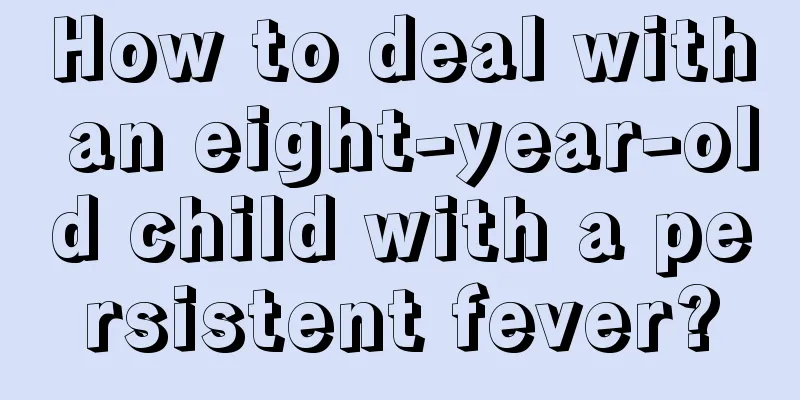Reasons for green stools in 2-month-old babies

|
There are many reasons why a 2-month-old baby's stool may turn green. This is because the baby's body resistance is still very weak in all aspects at 2 months old, and the organs that protect the body's health are not yet fully developed. Therefore, exposure to stale gas in the air or drinking inappropriate milk powder may be the cause of the baby's stool turning green. In this case, mothers should find a solution in time, such as ventilating the baby's room or changing to other brands of milk powder, which are all feasible and effective methods. This may be caused by the following reasons: (1) Milk is rich in iron, which is not fully absorbed and excreted in the stool, making the stool green. (2) The high-quality fats in some milk products are easy to digest, and less bile is consumed in the process. The excess bile is excreted in the stool, making the stool green. (3) When the intestine is inflamed or the bowel movements are too fast, the bilirubin in the intestine is excreted from the intestine before being converted, making the stool green. Children's digestive system is not yet fully developed, their stomach is small and flat, and their cardiac sphincter is relaxed. If they are fed improperly, the bilirubin in the bile they swallow will be a yellow pigment, and the feces will turn yellow after being stained by it. Bilirubin can be oxidized to biliverdin, which makes the stool green. The feces excreted by children on the diaper encounters oxygen in the air, which converts bilirubin into biliverdin, making the surface of the feces green. In addition, many bifidobacteria parasitize in the intestines of children, making the intestines acidic. The feces have been oxidized in the intestines and turned green before being excreted from the body. This is a normal physiological phenomenon. Generally, the stool of breastfed babies is acidic, slightly green in color, and sometimes mixed with some white particles. If a formula-fed baby has green stools, it means that the intestinal motility is accelerated or there is inflammation in the intestine, which is a symbol of diarrhea. Some parents think that their children’s green stools are caused by some kind of shock, which is wrong. Possible reasons why your baby's stool is green: 1. Babies may spit up milk or have green stools when they catch a cold or have indigestion. If you cannot determine which situation is causing it, you need to see a doctor to check the stool. If there is an infection, active treatment is required. If the test results are normal, the child may have indigestion or a cold abdomen. 2. When the child is not full, the child's gastrointestinal movement is too fast due to hunger, and the stool becomes green and watery. 3. If you think your baby eats a lot, it is because of indigestion. Give her Mommy Love. 4. In addition, for the health of the baby, it is necessary to take in enough iron. If the baby who eats milk powder containing iron cannot fully absorb the iron in the milk powder, the stool will be yellow-green, the white particles in the stool will be larger, and it will be more likely to have a foul odor. 5. Some babies often excrete a small amount of green vegetable puree in their stool when they first add vegetable puree. Some parents often think it is indigestion and stop adding vegetable puree. In fact, this phenomenon is common when healthy babies change their food. Observing the stool characteristics of infants and young children can help us understand their digestion conditions. In short, mothers should always pay attention to the growth and changes of their babies. Although green stools for a 2-month-old baby is not a tricky problem, corresponding countermeasures must be taken and it cannot be left unattended. If the green stool persists for a long time, be sure to take your baby to the hospital and receive treatment according to the doctor's advice so that your baby can recover health as soon as possible and grow up happily. |
<<: How to deal with a hard lump behind the baby's ear
>>: Consequences of a sunken anterior fontanelle in babies
Recommend
Treatment of true precocious puberty
Because people's living standards are much hi...
What should I do if my four-month-old baby doesn't grow hair?
If your baby doesn't grow hair for four month...
Child fell off the bed
Almost all babies often fall down, but the most m...
How to improve memory in teenagers
Nowadays, many teenagers are experiencing a decli...
How to treat children’s tics with traditional Chinese medicine?
Children's tics should be discovered and trea...
Sleep time for three-year-olds
The sleep time in each time period is different. ...
Treatment of the causes of tics in children
Parents care about their children's health an...
Why does a two-year-old baby cry at night?
I have always believed that it is normal for babi...
My child always feels something in his throat
Children are not particularly sensitive to abnorm...
What is the normal heart rate for children?
For parents, it is very necessary to understand t...
Causes of scabs on baby's eyebrows
After the baby is born, the body is not yet adapt...
What are the benefits of hula hoop gymnastics for children
Babies are the apple of the eyes of the whole fam...
How to treat children’s nasal congestion quickly?
If a child has a stuffy nose, it is most likely c...
How to do aerobics for children
As far as many kindergartens are concerned, many ...
How does a three-month-old baby develop?
For babies, due to physical reasons, newborns may...









